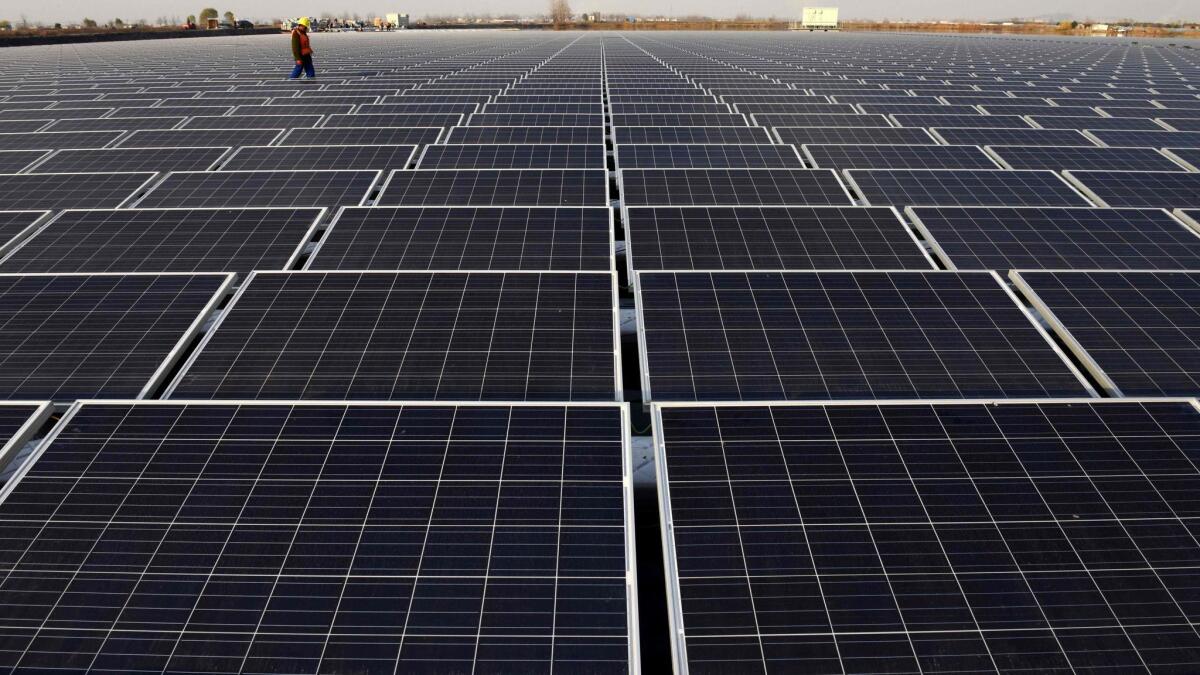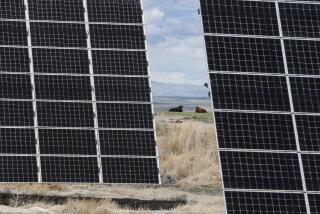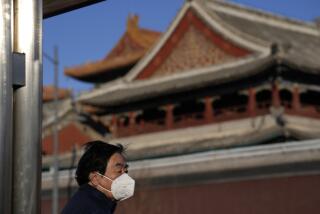Coronavirus could slow the world’s solar-energy revolution

- Share via
The coronavirus outbreak is threatening to slow the global solar energy revolution as it cuts the supply of key equipment for solar and wind farms in China and beyond.
As cases of the disease mounted over the last week, manufacturers including Trina Solar Ltd. sounded the alarm over production delays while developers such as Manila Electric Co. in the Philippines said projects would be held up.
“If the virus outbreak lasts beyond the first quarter and spreads to more geographies, as is currently happening in Korea and Italy, then it may very well slow down global renewable energy deployment,” said Ali Izadi-Najafabadi, head of analysis in Asia for BloombergNEF, which has downgraded its outlook for installations this year.
While China is slowly starting to get back to work after an extended shutdown to contain the virus’ spread, many factories are still not at full capacity amid a lack of staff and raw materials. Green manufacturers are not spared, with analysts and industry groups flagging the potential for higher costs and a hit to overseas operations, especially if the outbreak continues.
For now, the effect on green companies remains manageable and mainly confined to areas in China where the coronavirus was first found. Solar giant LONGi Green Energy Technology Co. has said it sees no significant effect on its panel sales and production and has kept shipment targets for the year unchanged.
Even so, the warnings that have started to trickle out are a reminder of China’s importance in the global supply chains involved in building clean-energy plants and reducing the pollution that’s damaging the climate.
The country leads the world both in installing new wind and solar farms and in producing photovoltaic panels used almost everywhere. Of the top 10 cell makers, nine are mainly Chinese manufacturers and one is from South Korea.
Overseas plants could be hit as they will be unable to receive components from China given flight restrictions, according to the China Photovoltaic Industry Assn. The group has asked the government to delay tariff cuts for domestic projects — meant to encourage solar plants to compete on their own against conventional fuels such as coal and natural gas — due at the end of March.
Wind power utilities in China have also requested that policymakers extend feed-in tariffs for onshore installations beyond this year, according to the Global Wind Energy Council, citing conversations with companies. The current policy requires wind farms cleared for construction through 2020 to be completed by 2021 to qualify for subsidies.
BNEF lowered its forecasts for solar and wind installations in China this year but cautioned that capacity can ramp up quickly after the outbreak and that disruptions won’t be enough to reverse an oversupply.
The analysts now expect a maximum of 43 gigawatts of solar installations this year from 45 gigawatts before. Its most pessimistic forecast is for 31 gigawatts compared with at least 37 gigawatts estimated previously. China added about 30 gigawatts last year, according to the industry association.
Here are some reports of delays by companies:
- On Monday, a Manila Electric unit said two solar projects will be delayed for months because solar panels were stuck in a factory in Hubei.
- China’s New Energy Chamber of Commerce said this month that production had been disrupted and will affect shipments of equipment to overseas markets. Its members include leading panel makers JinkoSolar Holding Co., Tongwei Co., LONGi Green Energy and Trina.
- Trina’s deputy general manager, Yin Rongfang, told the Economic Times on Feb. 20 that its factories had lower supplies than usual, boosting short-term logistics costs. Factory utilization took a hit but is rebounding.
- Photovoltaic production capacity has been hit in Jiangsu province, where more than 60% of China’s solar panels are made, according to the Gofa Institute, a wing of the government’s National Energy Administration. It said those plants are “gradually recovering.”
- In France, Claire Waysand, interim chief executive of the utility Engie, said the coronavirus outbreak would delay some solar and wind projects by “a few weeks” because some suppliers of photovoltaic panels and of blades for wind turbines are Chinese.
Some manufacturers are relying on production outside of China to cope. That’s especially true for two of the largest makers of inverters, which convert solar power into electricity for the grid.
SolarEdge Technologies Inc. said on an earnings call that increased capacity at factories in Hungary and Vietnam has helped it meet demand. It expects, however, to do air shipments this quarter in part because of the coronavirus, which put pressure on gross margins.
Enphase Energy Inc. is boosting manufacturing of microinverters in Mexico as a backup in case of supply disruptions. It’s seeing some sign of constraint from goods coming from China.
For Enphase, Mexico helps it “sidestep coronavirus challenges,” Philip Shen, an analyst at Roth Capital Partners, wrote in a note to clients.
So far, it’s the solar industry that has suffered more, with wind turbine makers bouncing back. Facilities owned by Vestas Wind Systems and Siemens Gamesa Renewable Energy in the city of Tianjin, in China’s northeast, are close to major ports and as yet not subject to any World Health Organization warnings on cargo transport from China.
“Vestas restarted production as planned on Feb. 15 and received further approval on Feb. 23, which has enabled us to significantly ramp up our production in China,” a spokesperson for the Danish turbine maker said. “We expect to return to full capacity soon, provided local conditions allow. We are seeing more suppliers resuming operations.”
More to Read
Inside the business of entertainment
The Wide Shot brings you news, analysis and insights on everything from streaming wars to production — and what it all means for the future.
You may occasionally receive promotional content from the Los Angeles Times.










